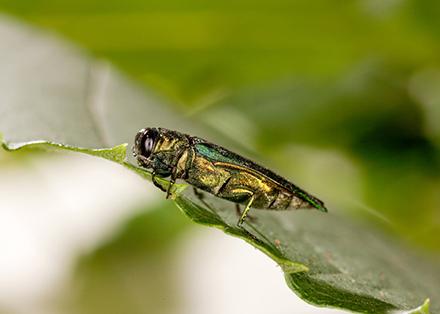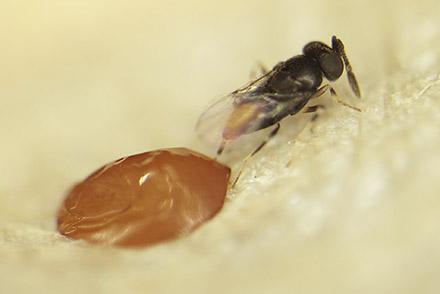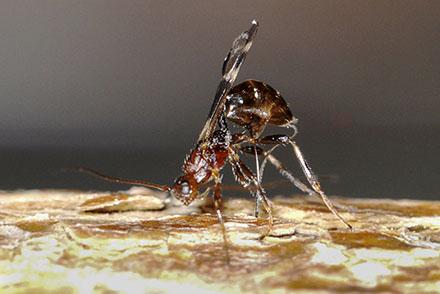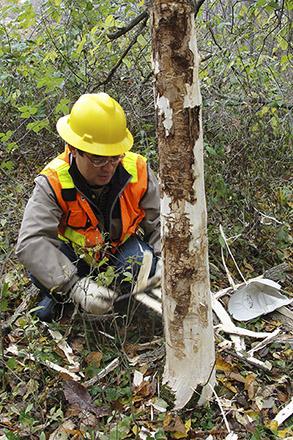Controlling Emerald Ash Borer

The emerald ash borer, Agrilus planipennis. It was detected in southern Michigan in 2002 and has since spread to 33 states. (Stephen Ausmus, D2138-6)
America’s sport—professional baseball—is under attack by a foreign invader, the emerald ash borer (EAB). This invasive pest has killed hundreds of millions of ash trees in North America since 2002, and fans of major league baseball know that ash wood is preferred for making baseball bats because of its resistance to splintering and its relatively light weight.
The EAB (Agrilus planipennis) has also cost local governments, property owners, nurseries, and forest industries hundreds of millions of dollars.

An emerald ash borer egg parasitoid, Oobius agrili. Introduced to the United States for biocontrol in 2007, it has established self-sustaining populations at some of the release sites in Michigan and other states. (Jian Duan, D4054-1)
Invasive pests have long been a problem for U.S. farmers, industry, and homeowners. The Agricultural Research Service (ARS) conducts research to help control these damaging pests. At the ARS Beneficial Insects Introduction Research Unit in Newark, Delaware, entomologist Jian Duan is researching two approaches to control EAB: beneficial insect releases and a genetic technology called RNA interference (RNAi).
The EAB is an exotic beetle that was found near Detroit, Michigan, in 2002. The adult beetles chew on ash tree leaves, causing little damage. But the larvae feed on the inner bark of ash trees, leaving the tree unable to transport water and nutrients throughout its tissues.

This parasitoid wasp, Spathius galinae, was introduced to the United States in 2015 to protect ash trees from emerald ash borer larvae. (Jian Duan, D4057-1)
EAB probably arrived in the United States on solid wood packing material (like crates) carried in cargo ships or airplanes originating in its native Asia. By 2018, EAB had made its way to 35 states and 3 Canadian provinces: Ontario, Quebec, and Manitoba.
Duan and colleagues at the U.S. Forest Service, USDA’s Animal and Plant Health Inspection Service, and the University of Massachusetts surveyed populations of EAB and its natural enemies on ash saplings over a 3-year study in six stands of deciduous forest in southern Michigan. At these study sites, the EAB populations collapsed after an introduced Asian parasitic wasp (Tetrastichus planipennisi) became widely established. The parasitic wasp, introduced by the research team, killed 36–85 percent of the EAB larvae in ash saplings, and there were abundant healthy ash saplings and small ash trees remaining in the six study sites.

In a hardwood forest near Lansing, Michigan, ARS entomologist Jian Duan debarks infested ash trees to collect data on emerald ash borer larval densities and parasitism by introduced biocontrol agents. (Leah Bauer-USDA Forest Service, D4053-1)
“These results indicate that the introduced biocontrol agent is providing significant biocontrol and enhancing ash survival and promoting its recovery in Michigan,” says Duan.
Duan and his colleagues are also using RNAi to target EAB. In this research, two double-stranded RNAs were fed to newly hatching EAB larvae in sugar water. Results showed that this technique silenced target genes in the EAB larvae, killing them after 10 days. “We also tested the two-double stranded RNAs against a nontarget beetle—Tribolium castaneum, the red flour beetle—and found no effect,” says Duan. “This research will help to develop a nontoxic pesticide specifically targeting EAB. These two avenues of control may be just what is necessary to control the damage caused by EAB infestations.”
This research was published in 2017 in Forest Ecology and Management. — By Sharon Durham, ARS Office of Communications.
You May Also Like

